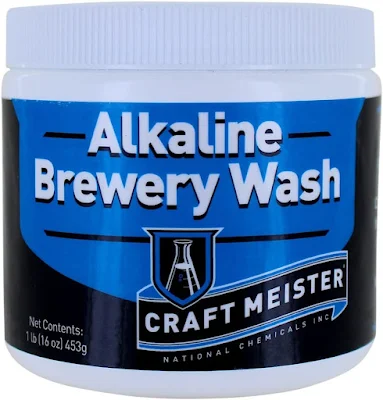When it comes to the critical practice of brewing hygiene, the selection of a cleaning agent is as fundamental as the malt bill or fermentation schedule. Brewers often weigh the merits of Alkaline Brewery Wash (ABW) and Powdered Brewery Wash (PBW), each offering a distinct approach to maintaining sanitary conditions vital for consistent and high-quality beer production.
The presence of unwanted microorganisms or residual brewing byproducts can lead to off-flavors, inconsistent fermentation, and ultimately, spoiled batches. Therefore, a thorough understanding of how these cleaners work at a scientific level is paramount.
This article will delve into the scientific principles behind the cleaning action of ABW and PBW, providing a comprehensive analysis to guide brewers in making an informed decision tailored to their specific brewing environment and needs.
Chemical Composition and Cleaning Efficacy: A Scientific Perspective
Alkaline Brewery Wash (ABW)
ABW typically employs a blend of alkaline salts, often including sodium carbonate or silicates, along with surfactants. The alkalinity, characterized by a high pH (typically above 11), saponifies fats and oils, breaking them down into more water-soluble compounds that can be easily rinsed away.Furthermore, the alkaline environment disrupts the cellular membranes of many microorganisms, contributing to their inactivation. The surfactants present reduce the surface tension of water, allowing the cleaning solution to penetrate and lift organic residues, such as proteins and carbohydrates left behind from the mash, boil, and fermentation stages.
A significant advantage of ABW is its effectiveness across a broader temperature spectrum. The kinetic energy of molecules plays a crucial role in cleaning efficiency; higher temperatures generally accelerate chemical reactions and increase the solubility of residues. However, ABW's formulation allows it to maintain a significant degree of cleaning power even at lower temperatures.
This is partly due to the specific types and concentrations of alkaline compounds and surfactants used, which are designed to be effective without requiring excessive thermal energy. This not only saves energy but also reduces the risk of protein denaturation and adherence to surfaces that can occur at higher temperatures, making rinsing more difficult.
Powdered Brewery Wash (PBW)
PBW distinguishes itself through a more complex formulation, typically including sodium metasilicate, a highly alkaline compound that effectively hydrolyzes organic matter. The inclusion of chelating agents, such as phosphates or EDTA (ethylenediaminetetraacetic acid), is a key feature.These chelators work by forming stable complexes with metal ions (e.g., calcium, magnesium, iron) present in hard water and brewing residues. By sequestering these ions, chelators prevent them from interfering with the cleaning process and from depositing as scale or beer stone (calcium oxalate) on equipment surfaces. Beer stone can harbor microorganisms and is notoriously difficult to remove.
PBW's efficacy is significantly enhanced at higher temperatures because the increased thermal energy boosts the activity of both the alkaline components and the chelating agents, accelerating the breakdown of organic soils and the solubilization of mineral deposits. However, this temperature dependency implies a greater energy demand for optimal performance.
The initial purchase price often makes ABW appear more economical, a crucial factor for budget-conscious brewers. Beyond the upfront cost, the ability of ABW to perform effectively at lower temperatures translates to potential savings in heating energy, contributing to long-term operational efficiency and a lower overall cost of cleaning.
Cost-Effectiveness and Usage Concentrations: An Economic and Chemical Equilibrium
Cost ConsiderationsThe initial purchase price often makes ABW appear more economical, a crucial factor for budget-conscious brewers. Beyond the upfront cost, the ability of ABW to perform effectively at lower temperatures translates to potential savings in heating energy, contributing to long-term operational efficiency and a lower overall cost of cleaning.
This is particularly relevant in regions with high energy costs or for brewing setups where heating large volumes of cleaning solution is resource-intensive.
Usage Efficiency
PBW's concentrated formulation suggests that a smaller amount of product might be needed per unit volume of cleaning solution to achieve the desired level of cleanliness. This higher cleaning power at lower concentrations can potentially offset its higher per-unit cost over time. Brewers must carefully consider the recommended dilution ratios and the total amount of cleaner used over multiple cleaning cycles to accurately assess the long-term cost-effectiveness of each option.
PBW's concentrated formulation suggests that a smaller amount of product might be needed per unit volume of cleaning solution to achieve the desired level of cleanliness. This higher cleaning power at lower concentrations can potentially offset its higher per-unit cost over time. Brewers must carefully consider the recommended dilution ratios and the total amount of cleaner used over multiple cleaning cycles to accurately assess the long-term cost-effectiveness of each option.
Factors such as the frequency of cleaning, the volume of cleaning solution required, and the severity of fouling will influence the overall expenditure.
The environmental impact of brewing chemicals is an increasingly important consideration. ABW's non-caustic nature often translates to better biodegradability and reduced harm to aquatic ecosystems if discharged in wastewater (though proper disposal according to local regulations is always essential). The breakdown products of ABW components are generally less persistent and less toxic compared to some of the more aggressive chemicals found in certain formulations of PBW.
Environmental Impact and Safety: Balancing Ecological Responsibility and User Well-being
Ecological ConsiderationsThe environmental impact of brewing chemicals is an increasingly important consideration. ABW's non-caustic nature often translates to better biodegradability and reduced harm to aquatic ecosystems if discharged in wastewater (though proper disposal according to local regulations is always essential). The breakdown products of ABW components are generally less persistent and less toxic compared to some of the more aggressive chemicals found in certain formulations of PBW.
However, it's crucial to note that the environmental impact of any cleaning agent depends on its complete formulation, concentration used, and the wastewater treatment processes in place.
User Safety
The non-caustic nature of many ABW formulations generally presents a lower risk of chemical burns and respiratory irritation for users. This can be a significant advantage in environments where safety protocols might be less stringent or where users may have less experience handling strong chemicals.
The non-caustic nature of many ABW formulations generally presents a lower risk of chemical burns and respiratory irritation for users. This can be a significant advantage in environments where safety protocols might be less stringent or where users may have less experience handling strong chemicals.
While PBW is also safe when handled correctly, its alkaline components, particularly sodium metasilicate, can be corrosive and irritating to skin, eyes, and the respiratory tract.
Therefore, the use of appropriate personal protective equipment (PPE), such as gloves, eye protection, and potentially respirators, is even more critical when working with PBW to mitigate these risks. Brewers must prioritize safety training and ensure adherence to safety guidelines for whichever cleaner they choose.
Versatility and Material Compatibility: Ensuring Broad Application and Equipment Longevity
Versatility in the BreweryThe versatility of both ABW and PBW stems from their ability to address a wide range of organic and inorganic soils encountered throughout the brewing process. This includes removing krausen rings from fermenters (composed of proteins, hop resins, and yeast), wort residues from brew kettles (sugars and caramelized solids), and beer stone buildup in serving tanks and lines (mineral deposits).
The ability to use a single cleaner for multiple applications simplifies inventory management and cleaning protocols, contributing to operational efficiency.
Compatibility with Materials
The long-term integrity of brewing equipment is paramount, making material compatibility a non-negotiable factor in cleaner selection. While stainless steel, the primary material in most brewing systems due to its inertness and cleanability, is generally compatible with both ABW and PBW, other materials require careful consideration.
For instance, prolonged exposure to highly alkaline solutions like some PBW formulations can degrade certain types of rubber gaskets and seals, leading to leaks and potential contamination. Similarly, softer metals like aluminum or copper can be corroded by strong alkaline cleaners. Brewers must consult the manufacturer's recommendations for both their cleaning agents and their brewing equipment to ensure compatibility and prevent damage that could compromise the quality of their beer or necessitate costly repairs.
The decision between Alkaline Brewery Wash and Powdered Brewery Wash hinges on a nuanced evaluation of their chemical properties, cleaning mechanisms, cost implications, environmental footprints, safety profiles, and material compatibilities within the specific context of a brewery's operations.
The decision between Alkaline Brewery Wash and Powdered Brewery Wash hinges on a nuanced evaluation of their chemical properties, cleaning mechanisms, cost implications, environmental footprints, safety profiles, and material compatibilities within the specific context of a brewery's operations.
There is no universally "best" cleaner; rather, the optimal choice is the one that most effectively addresses the unique challenges and priorities of the brewing environment. Factors such as the scale of operation, the types of beers brewed (which can influence the nature and tenacity of residues), water hardness, energy costs, waste disposal regulations, and the brewery's commitment to safety and sustainability all play a crucial role in this decision-making process.
Ultimately, the thorough comparison of ABW and PBW highlights the scientific and practical considerations involved in maintaining impeccable brewing hygiene.
Ultimately, the thorough comparison of ABW and PBW highlights the scientific and practical considerations involved in maintaining impeccable brewing hygiene.
By understanding the underlying chemistry of these cleaners and their interactions with brewing soils and equipment, brewers can make informed choices that not only ensure the production of consistently excellent beer but also align with their operational efficiency, safety standards, and environmental stewardship goals. Whether a brewery opts for the gentler, potentially more cost-effective ABW or the powerful, chelation-enhanced PBW, the unwavering commitment to cleanliness remains the cornerstone of successful brewing.






